Forty years after the publication of her groundbreaking book, The Writer on Her Work (1980), author and photographer Janet Sternburg donated her papers relating to the book and its follow-up volume, The Writer on Her Work: New Essays in New Territory (1991), to the Ransom Center.
Both books bring together a diverse range of voices—including Margaret Atwood, Anita Desai, Rita Dove, Diane Johnson, Maxine Hong Kingston, and Alice Walker, among many others—in essays commissioned by Sternburg exploring how they became writers, why they write, and what it means to be a woman and a writer. Sternburg noted in the introduction to the first volume, “The woman writer as we’ve stereotypically known her has been many things: recluse, sufferer, woman in mauve velvet on a chaise, woman who flees the stifling rooms of her father’s house, adventuress, ‘free’ woman of multiple love affairs, paragon of productivity, destroyer of others, more often of herself. The images are all too familiar—away with them.”
Adrienne Rich wrote of the first volume, “The Writer on Her Work is a collection which belongs on many reading lists, beside the bed, in the library, alongside the desk, in the classroom, in the bag that holds the notebooks and manuscripts.”
In her preface to the twentieth-anniversary edition of the first volume, Julia Alvarez asked, “Why do I keep reading this book and why do I keep assigning it to my young writing students, male and female?… The struggle to create, a struggle exacerbated and transformed by the historical moment in which we find ourselves writing—how our gender, race, class play out in that particular place and time—is a struggle that every young writer experiences… The private struggle expands and becomes a connection to others.”
The archive documents the creative process behind The Writer on Her Work through manuscripts, notes, research materials, correspondence with contributors, editorial papers, and other materials. Shortly after the collection arrived at the Ransom Center, Janet Sternburg reflected on The Writer on Her Work and the archive in the following interview. Her newest book, published this month, is I’ve Been Walking: Janet Sternburg, Los Angeles Photographs.
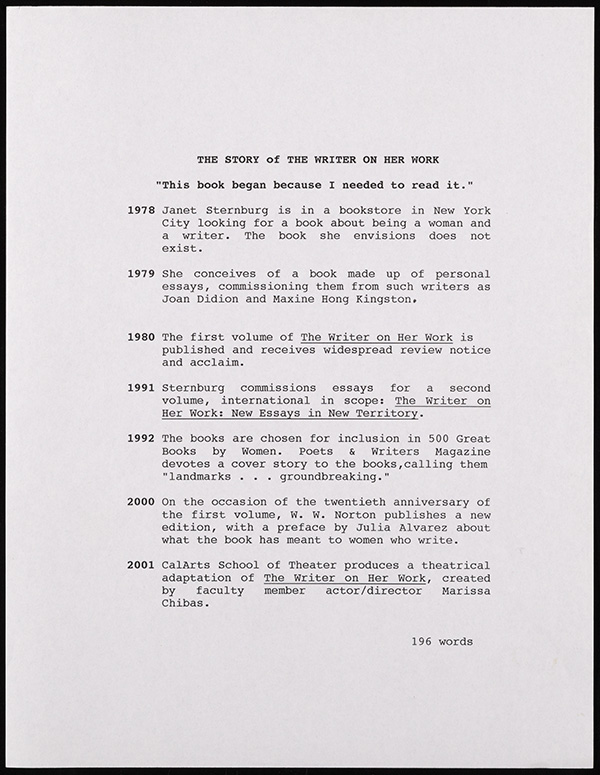
If you’re lucky, you get to tell a story many times over, which gives the story staying power. But there’s a catch: you find yourself saying the same things again and again. This happened to me during the 40 years since the publication of the two volumes of The Writer on Her Work. Thank you, Harry Ransom Center, for giving me this opportunity to add new material to the story of The Writer on Her Work. The books have stood the test of time. Why not think again?
—JANET STERNBURG
You wrote in your introduction to the first volume of The Writer on Her Work, “my own intricate patterns have altered with becoming a woman and a writer. As part of that change, I’ve wanted to know how other women came to write and how they see their lives and their work.” What especially notable commonalities of experience or themes did you observe in the contributors’ essays about their lives as women writers?
We need to place the books in context. In the late nineteen seventies when Volume One took shape, the commonalities were mainly obstacles in the outside world, self-doubt in the inner and, most of all, struggle. To these circumstances I would add valor, a commitment to prevail, to say what was ours to say. The range of writers included makes generalization dicey, but I think I’m being fair to the spirit of the times and of the books. Until its publication, no such book—a collection of what it meant to be a contemporary woman who writes—existed, hard though that is to believe now. Part of the staying power of that first book was that the essays were fresh, not mostly polemic but instead what I wanted when I commissioned them: personal experiences interwoven with speculative ideas. It turned out that this material was waiting, ready to be shared. The first volume became a friend to its readers. As a 1981 review from the Philadelphia Inquirer said, “it speaks to the active creative spirit.”
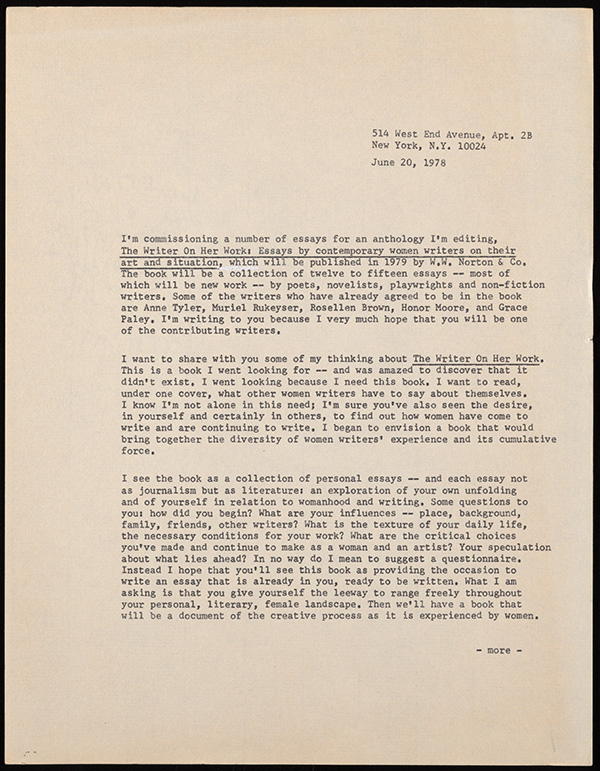
As time went on, what expanded your vision for a second volume?
It was clear to me that several things had happened in the intervening decade. Women’s voices from all over the world were being heard. The essays I commissioned then were from writers from Argentina (Luisa Valenzuela), England (Jan Morris), Chickasaw Nation (Linda Hogan), Mexico (Elena Poniatowska), and the United States (Ursula Le Guin, Maxine Kumin, Rita Dove, et al).
The other change was that writers were less preoccupied with the struggle of self, and more engaged with the larger world. New themes emerged, among them a belief that the experiences of one’s own life—sometimes seen in the past as only trivial—were instead a valid base for writing.
Yet another marker of change appeared with the publication of the twentieth anniversary of Volume One. There were celebrations, occasions for meeting up with one another and also, for me, a concern: Did this book still have relevance to younger women who felt more empowered than my generation had? For an article in The Women’s Review of Books, I asked several women in their twenties—former students from when I taught at CalArts—what if anything the book meant to them. They surprised me by an answer upon which they all agreed: “You all had such a romance with your work. We don’t have that now—we’re more consumed with practical matters. You had to be too—but writing for you was vocation, passion, mission—and that is useful to us now.”
The archive includes many lists of writers you considered as possible contributors to the books. If you were inviting essays for the books today, who are some of the writers you would want to include?
I don’t think there should be another book of this sort. There are times when you can make an intervention in the culture, when what you do is uniquely needed. I sensed that moment and seized it. Now I look forward to reading other voices, female and male, in all their breadth and depth. I’m thrilled though to discover on the internet as I did the other day, a young woman who found the books and wrote that they gave her a vision of what she wants to become. So they continue to point to the future.
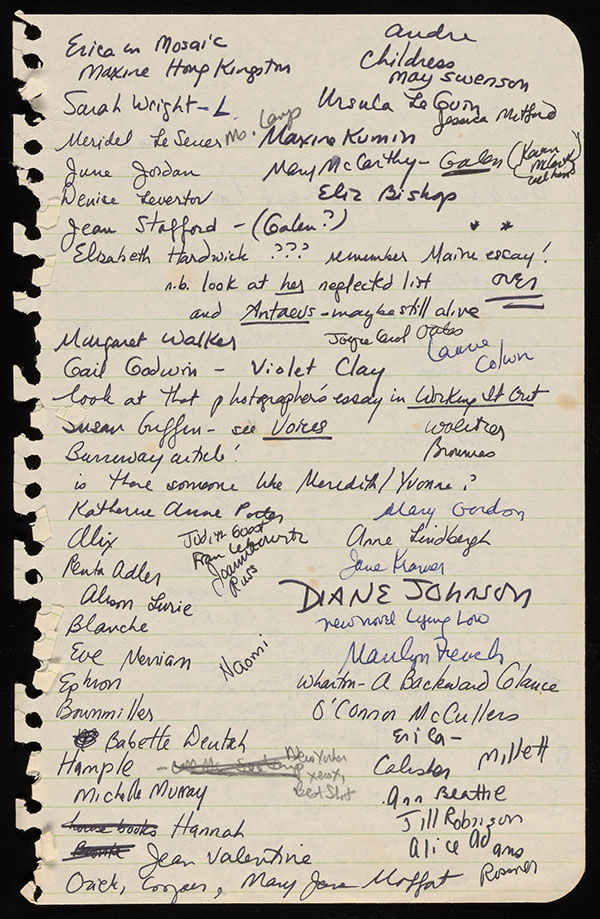
How did your experience creating The Writer on Her Work impact your own writing life?
I learned a number of things. Here’s one thing I would not do again: I left myself out of the book. I didn’t write my own essay, separate from my introduction. I told myself that I didn’t want The Writer on Her Work to be like collections that seemed to exist so that an editor could insert himself. If truth be told, though, what was really at stake is that I didn’t think myself worthy, an inheritance from parents who saw themselves as not good enough. It took me a long while to learn that radical self-doubt is not a sign of authenticity, but instead is boring when it goes on too long.
Another thing I won’t do again is work with other writers’ words. The Writer on Her Work—for all that the making of it was a creative act—depended on the contributions of others. Those were the years when I made a film on Virginia Woolf for public television, and staged theatre pieces on Colette, H. D., Raymond Chandler, Isak Dinesen and S. J. Perelman when I directed Writers in Performance at the Manhattan Theatre Club. There was no single event that caused the shift to my own words and images. Rather it was a number of changes, a continuum: a new marriage that brought with it a move to another coast, a bout of cancer, an earthquake—a literal one that brought home to me a sense of “If not now, when?”
Back in the days of the second volume of The Writer on Her Work, I wrote to Eudora Welty to ask whether she would write an essay. She wrote back that while she would like to, “I am now the writer at my work.” That’s what I’ve become too, and also a photographer at my work, a parallel vocation begun at midlife. Since the second volume of The Writer on Her Work, I’ve written books that combine family history and neurology: Phantom Limb, A Meditation on Memory and White Matter, A Memoir of Family and Medicine; also a book of poetry with photographs, Optic Nerve: Photopoems. There are also two monographs, Overspilling World: The Photographs of Janet Sternburg and right now, I’ve Been Walking: Janet Sternburg, Los Angeles Photographs. I don’t like stories that smack of triumphalism. There’ll always be boulders in the road for me, as for most of us, but we can push them out of the way and go forward.
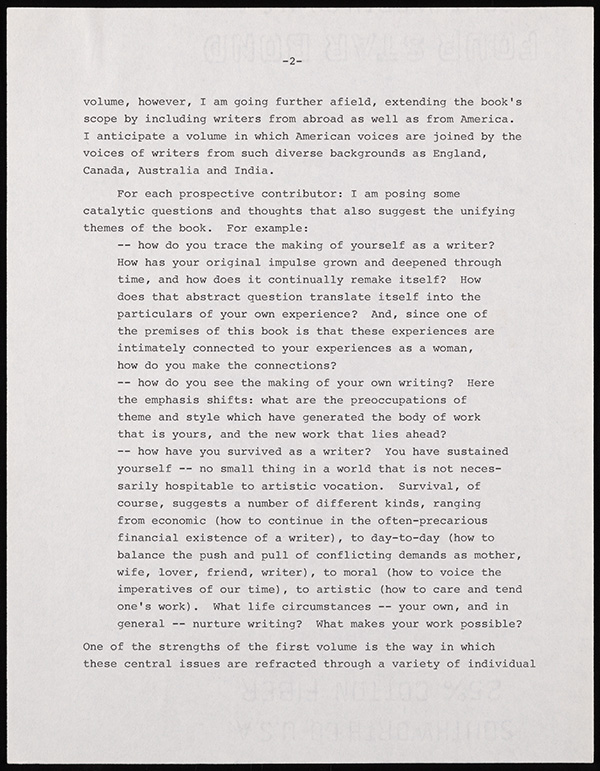
When you identified potential contributors for both volumes, you made a deliberate effort to include diverse voices. The text on the dust jacket begins, “This is a book that celebrates diversity,” and this emphasis on diverse perspectives seems essential to the books. How do you think this focus on diversity shaped the books and their impact on readers?
Anything that widens the conversation, widens the impact. To me, diversity isn’t token representation—it’s a word that means everything, all of it, the whole spectrum. I threw aside considerations of commonalities and differences and focused on stories that had not been heard before—and of course those stories come from diverse sources. What else? Who else? Whose work do I love? Who wants to come out from a hidden place and make herself known?
I was at the MacDowell Colony during the planning phase of the first volume and had come to know Tillie Olsen who said, “There’s this woman who was a marvelous writer and died young. She left behind her journals. You might want to find them.” I did, and Michele Murray’s beautiful and poignant voice came into the light. It was a huge satisfaction when some years later, sitting in my office at my day job, I heard a knock on the door. It was Murray’s husband and son, who wanted to say that she had been kept alive through what mattered: her words.
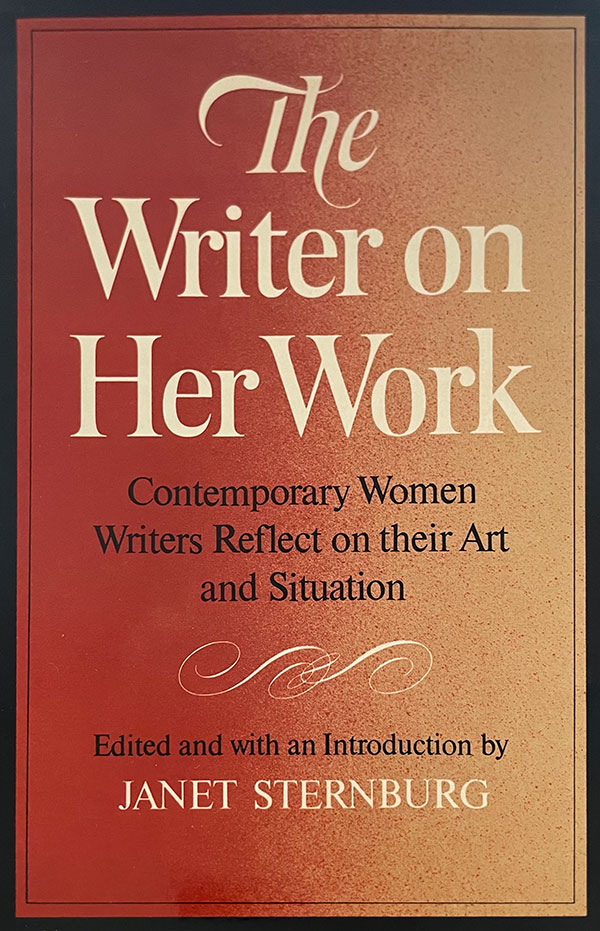
What do you hope students, researchers, or readers might learn from this archive?
I think there are multiple entrances to the archive. For students, researchers, and scholars, it opens the door to the history of a particular time. What it was like then: the felt experience rising off the pages, as well as new aspects of individual writers whose papers are also at the Ransom Center. For those interested in the business of writing and publishing, there is information about contracts, correspondence, editing notes, financial arrangements. On the last, I chose to share the royalties with the contributors, a modest sum that through the years gave each of us, as Maxine Hong Kingston once humorously remarked to me, the wherewithal to buy “a new item of clothing, like a blouse, each year.” For writers and artists, I hope they find inspiration, and this is true for everyone, the spirit of these words of Louise Bogan which I chose as the epigraph for both books:
“In a time lacking in truth and certainty, and filled with anguish and despair, no woman should be shamefaced in attempting to give back to the world, through her work, a portion of its lost heart.”
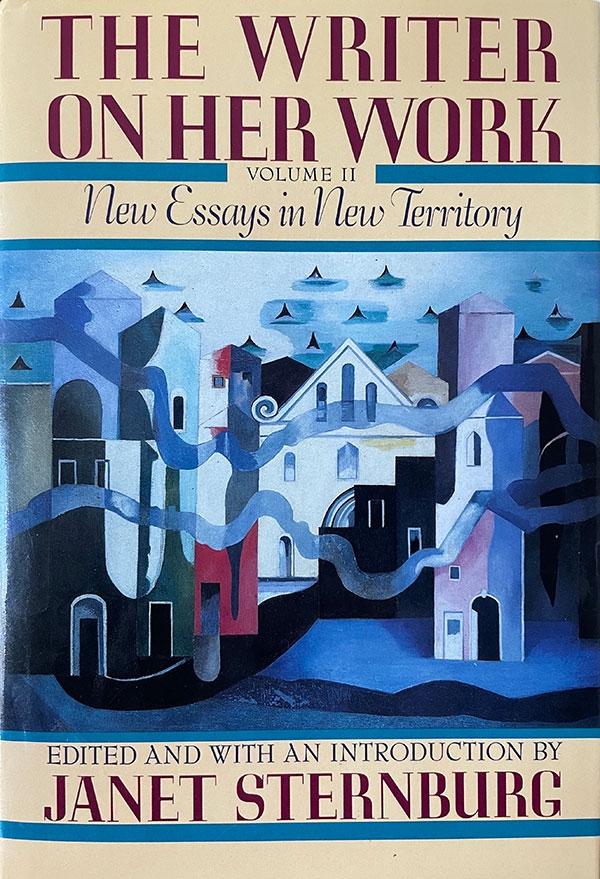
Postscript:
The title The Writer on Her Work did what I wanted it to do: begin with the vocation and claim it by the possessive “her.” In her preface written for the twentieth-anniversary edition, Julia Alvarez wrote: “It was a first: seventeen women laying claim to rooms of their own in the mansion of literature.” Seventeen—just the beginning.
In 2021, I stood outside my studio and watched as cartons were carried down the hallway on the way to the Ransom Center. I waved goodbye and wished them well. But no long-term relationship is ever truly over. Thanks to the good offices of Megan Barnard and Gretchen Henderson of the Center, and Ladette Randolph of Ploughshares, each of whom helped to shepherd them to their new home, the making of The Writer on Her Work belongs to the world now.
Image Featured
A page from Janet Sternburg’s list of possible contributors to The Writer on Her Work, 1978. Janet Sternburg Papers, Harry Ransom Center.
